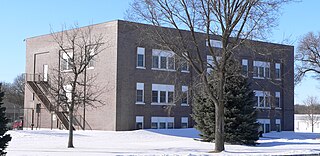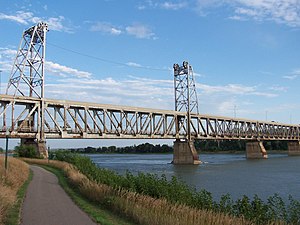
Yankton County is a county in the U.S. state of South Dakota. As of the 2020 United States Census, the population was 23,310. Its county seat is Yankton. Yankton County comprises the Yankton, SD Micropolitan Statistical Area.

Knox County is a county in the U.S. state of Nebraska. As of the 2010 United States Census, the population was 8,701. Its county seat is Center. Knox County was named for Continental and U.S. Army Major General Henry Knox.

Dixon County is a county in the U.S. state of Nebraska. As of the 2010 United States Census, the population was 6,000. Its county seat is Ponca. The county was created in 1856 and attached to Dakota County. It was organized in 1858.

Cedar County is a county in the U.S. state of Nebraska. As of the 2010 United States Census, the population was 8,852. The county seat is Hartington. The county was formed in 1857, and was named for the Cedar tree groves in the area.

Yankton is a city in and the county seat of Yankton County, South Dakota, United States.
George Shannon (1785–1836), the youngest member of the Lewis and Clark Expedition, was born in Pennsylvania of Irish ancestry. He joined the Corps of Discovery in August 1803, as one of the three men from Pittsburgh recruited by Lewis as he was waiting for the completion of the voyage's vessels in the city.

The National Register of Historic Places in the United States is a register including buildings, sites, structures, districts, and objects. The Register automatically includes all National Historic Landmarks as well as all historic areas administered by the U.S. National Park Service. Since its introduction in 1966, more than 90,000 separate listings have been added to the register.

Lewis and Clark Lake is a 31,400 acre (130 km²) reservoir located on the border of the U.S. states of Nebraska and South Dakota on the Missouri River. The lake is approximately 25 miles (40 km) in length with over 90 miles (140 km) of shoreline and a maximum water depth of 45 feet (14 m). The lake is impounded by Gavins Point Dam and is managed by the U.S. Army Corps of Engineers, Omaha District.
The Missouri National Recreational River is a National Recreational River located on the border between Nebraska and South Dakota. The designation was first applied in 1978 to a 59-mile section of the Missouri River between Gavins Point Dam and Ponca State Park. In 1991, an additional 39-mile section between Fort Randall Dam and Niobrara, Nebraska, was added to the designation. These two stretches of the Missouri River are the only parts of the river between Montana and the mouth of the Missouri that remain undammed or unchannelized. The last 20 miles of the Niobrara River and 6 miles of Verdigre Creek were also added in 1991.

The Chief Standing Bear Memorial Bridge is a bridge across the Missouri River at the Nebraska-South Dakota border. Located near Niobrara, Nebraska, not far downstream from the confluence of the Niobrara River with the Missouri, it joins Nebraska Highway 14 to South Dakota Highway 37.

The Discovery Bridge is a bridge that carries US Route 81 across the Missouri River from the Nebraska border to the South Dakota border. The Discovery Bridge connects Yankton, South Dakota, with rural Cedar County, Nebraska. The ribbon-cutting ceremony was on October 11, 2008, a year ahead of schedule. During the ceremony John McAuliffe and Kevin Brown inadvertently cut the ribbon prior to photographers being in place and thus there is no commemorative photo. The bridge crosses over the Missouri National Recreational River, a Federally-protected Wild & Scenic River, managed by the National Park Service

The following outline is provided as an overview of and topical guide to South Dakota:

The Burlington, Cedar Rapids and Northern Railway (BCR&N) was a railroad that operated in the United States from 1876 to 1903. It was formed to take over the operations of the bankrupt Burlington, Cedar Rapids and Minnesota Railway, which was, in turn, the result of merging several predecessor lines, the construction of which began in 1869. The corporate headquarters were in Cedar Rapids, Iowa, and it had operations in Iowa and in Minnesota. It was succeeded by the Chicago, Rock Island and Pacific Railway.

U.S. Highway 77 (US 77) is the shortest U.S. Highway in the state of Iowa. It crosses into Iowa over the Missouri River from South Sioux City, Nebraska, at Sioux City and runs approximately three-tenths mile (500 m) to an interchange with Interstate 29 where the road continues north as Wesley Parkway. Like all other state highways in Iowa, the route is maintained by the Iowa Department of Transportation.
Aten is an unincorporated community and census-designated place in Cedar County, Nebraska, United States. As of the 2010 census it had a population of 112.

Calumet Bluff is a hill about 180 feet high overlooking Lewis and Clark Lake and the Missouri River in Cedar County, Nebraska, U.S., where the Lewis and Clark Expedition held its first council with the Sioux Indians for two days in 1804. Today the Bluff forms the right or south abutment of the Gavins Point Dam. The U.S. Army Corps of Engineers maintains the Lewis and Clark Visitor Center and the Gavins Point Project Administration Offices on Calumet Bluff overlooking the dam.
This timeline of South Dakota is a list of events in the history of South Dakota by year.
Green Island, 10.5 square miles of land in northwestern Cedar County, Nebraska bordering the Missouri River across from Yankton, SD, was home to Strahmburg a former town on the island. Green Island and Strahmburg have had their names used interchangeably over the years because, in part, the post office in Strahmburg was officially designated as Green Island. Supposedly Green Island acquired its name came the color of its lush vegetation. Though called an island, it was physically connected to Nebraska by a swampy, low-lying area along its southern edge. Both were destroyed by the Great Flood of 1881 on the Missouri. Their history is better understood knowing the braided, meandering, flood-prone history of the Missouri River in that area. Completion of Gavins Point Dam in 1957, 5 miles upriver from the former location of Strahmburg, greatly reduced the risk of floods on the river. Today the Missouri National Recreational River, 59-miles between Gavins Point Dam and Ponca State Park, has restrictions on commercial development. Early maps indicate the presence of numerous islands some of which, like Green Island, no longer exist.

Lake Yankton, also called Cottonwood Lake, is an artificial lake that was originally part of the main channel of the Missouri River on the border of the U.S. States of Nebraska and South Dakota, near Yankton, South Dakota. The lake has an approximate surface area of 250 acres (100 ha) and has a maximum depth of 18 feet (5.5 m). The lake is located immediately downstream (east) of Gavins Point Dam and Lewis and Clark Lake, located just north of the current location of the main channel of the Missouri River.

















